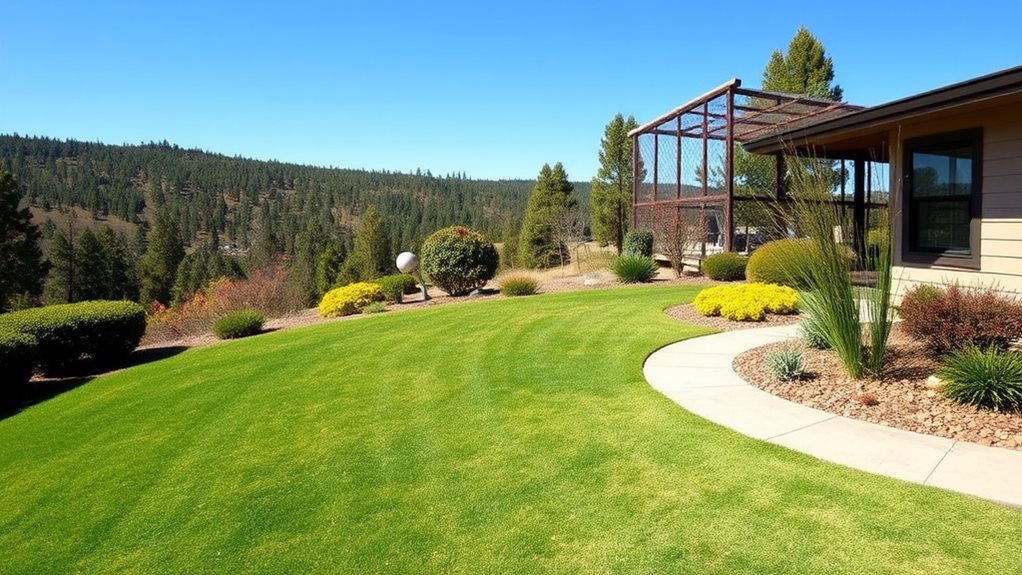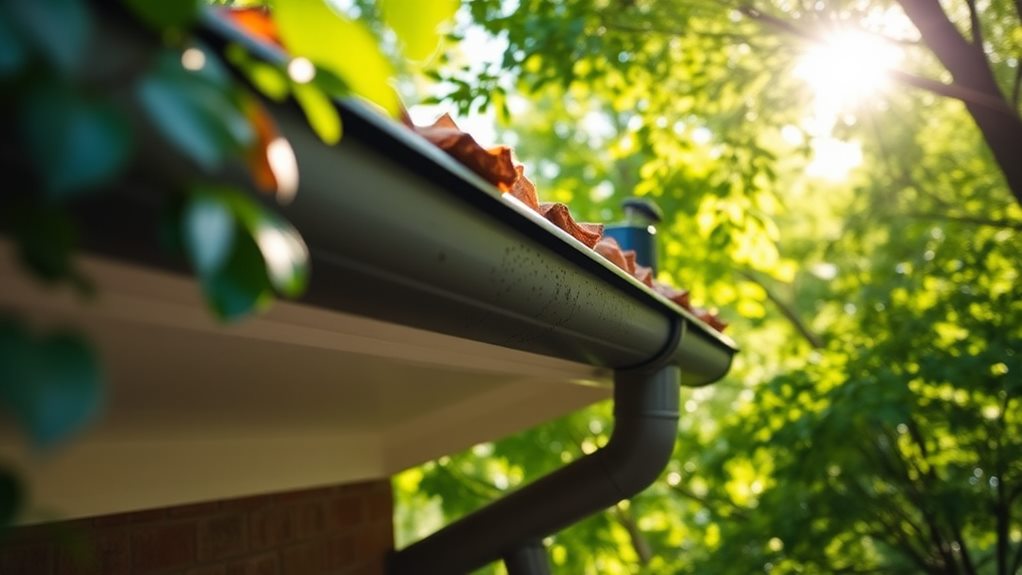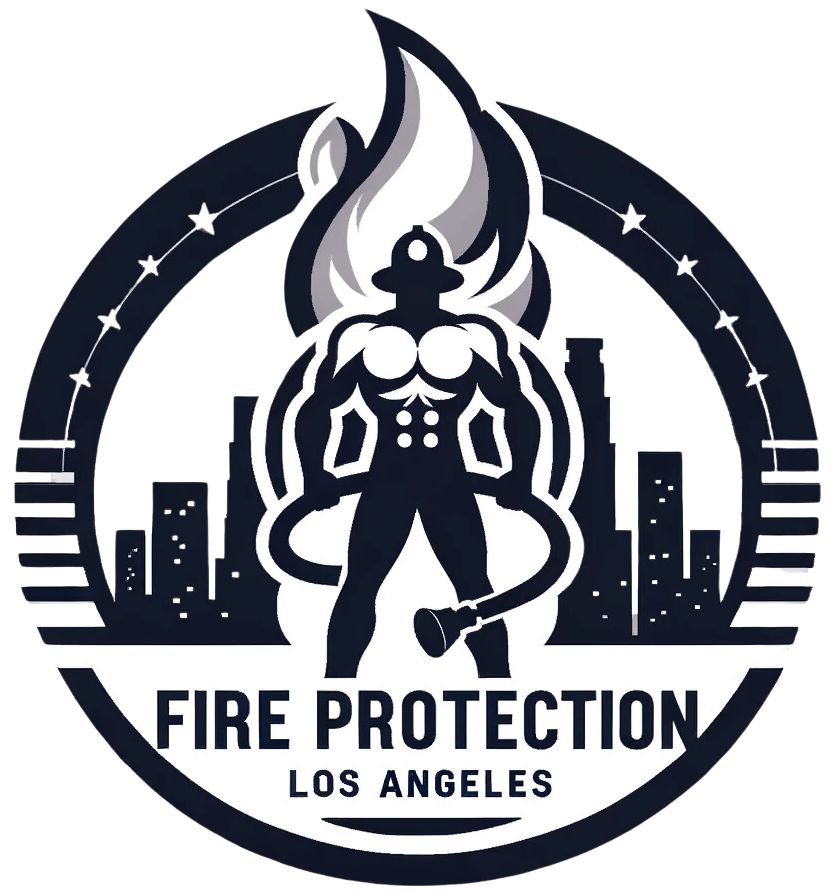To fireproof our homes against wildfires, we should take several important steps. First, we need to create a defensible space by maintaining at least 30 feet around our homes, removing dead vegetation, and spacing out trees. Next, using fire-resistant materials, like metal roofs and stucco siding, is essential. We must also keep our gutters clean and install noncombustible covers to prevent debris. Choosing heavy-duty dual-pane windows will help reduce heat transfer, while safe landscaping with fire-resistant plants minimizes fire risks. Taking these steps can greatly enhance our home's safety, and there's more we can do beyond these basics.
Create a Defensible Space

To protect our homes from wildfires, we need to create a defensible space. This means maintaining a clear zone of at least 30 feet around our homes. In this area, we should remove dead vegetation and space out trees to reduce fire intensity.
It's essential to regularly assess our defensible space and make necessary adjustments to keep it effective. Implementing fire-resistant materials in this zone, such as metal roofs and stucco sidings, can further enhance our protection against wildfires.
In the immediate zone, which is 0-5 feet from our homes, we must clean roofs, repair shingles, and install mesh screening to prevent embers from igniting our houses.
Moving into the intermediate zone, from 5-30 feet, we should clear away flammable vegetation, create fuel breaks, and prune trees at least 6 inches above the ground. This helps minimize fire risks and keeps flames at a safe distance from our structures.
We can enhance our defensible space further by incorporating fire-resistant landscaping and using non-combustible materials in our gardens.
Use Fire-Resistant Materials
Fire-resistant materials are essential for safeguarding our homes against wildfires. By choosing the right materials, we can greatly reduce the risk of ignition from flames or flying embers that might travel from nearby fires.
Implementing fire safety protocols alongside these materials enhances our home's resilience. Here are three key items to think about:
- Fire-Resistant Roofing Material: Opt for materials like metal, clay, or tile to protect our roofs from ignition.
- Noncombustible Siding: Use stucco, fiber cement, or treated wood for siding as they resist heat and help prevent fire spread.
- Dual-Paned Tempered Glass: Installing these windows enhances our home's resistance to radiant heat and decreases the chance of breakage during a wildfire.
Additionally, we should verify that decks and patio covers are made from noncombustible materials like composite or aluminum. This choice can help prevent fire from igniting due to adjacent vegetation or flying embers.
Finally, covering all vents with 1/8-inch mesh screens can effectively block embers from entering our homes.
By making these choices, we can fireproof our homes and enhance our safety against wildfires while maintaining a strong Defensible Space.
Let's take these steps together to protect our homes!
Maintain Your Gutters

Keeping our gutters clear is a essential step in fireproofing our homes against wildfires. Regularly cleaning our gutters helps to remove leaves, twigs, and other flammable material that can ignite during a wildfire, especially in areas where wildfires have burned considerably more land in recent years, as noted by the importance of fire-resistant design.
Installing noncombustible gutter covers can greatly reduce debris accumulation, making it easier to maintain fire protection for our homes.
It's also important to guarantee proper drainage in our gutters to prevent water buildup. Standing water can attract pests and lead to deterioration, which can weaken our home hardening efforts. We should inspect gutters frequently, especially during high-risk wildfire seasons, to make certain they're functioning correctly.
Using metal gutters is another effective choice since they're more fire-resistant compared to traditional plastic or untreated wood options.
By taking these steps, we can minimize the risk of fire hazards related to our gutters. Keeping the area around our homes clear of debris and verifying our gutters are in good shape plays a essential role in protecting our families and properties.
Let's prioritize maintaining our gutters as part of our overall fire safety plan.
Install Heavy-Duty Windows
When it comes to safeguarding our homes from wildfires, installing heavy-duty windows is an essential step we shouldn't overlook. Choosing the right windows can make a significant difference in protecting our living spaces from heat and embers, especially in areas located in the wildland-urban interface.
Given the increased risk of wildfires due to climate change, it's important to prioritize these protective measures. Here's what we should consider:
- Opt for Dual-Pane Windows: These windows offer better insulation and reduce heat transfer, helping to keep our homes cooler during a wildfire.
- Use Tempered Glass: This type of glass is fire resistant and can withstand higher temperatures, reducing the chance of breakage during a fire event.
- Install Window Screens: Plastic-clad fiberglass screens can effectively block embers from entering our homes, which is essential since these tiny particles can ignite flammable materials.
Additionally, we must verify that window seals are intact, as gaps can compromise their effectiveness against heat and smoke infiltration.
Regular inspection and maintenance of our windows are critical, especially during wildfire season, to guarantee that these protective features function properly.
Choose Safe Landscaping Options

Landscaping plays an essential role in protecting our homes from wildfires. To effectively defend against wildfires, we should choose safe landscaping options that can help reduce fire risk.
First, we need to select fire-resistant plants, such as lavender, sage, and ornamental grasses, which create a natural barrier around our homes. These plants not only beautify our yards but also slow down fire spread.
It's important to maintain a minimum of 10 feet between trees. This distance minimizes the risk of fire jumping from one tree to another, potentially reaching our property.
Regularly watering our landscaping keeps plants healthy and hydrated, making irrigated areas more resistant to fire.
We should avoid using untreated wood and highly flammable plant species like juniper and certain eucalyptus, as they can ignite easily and increase fire risks.
Consulting local landscaping experts can provide us with site-specific advice on suitable plant selections and fire-resistant landscaping practices tailored to our region, especially in areas prone to wildfires, like the Urban Interface.
Final Thoughts
In summary, preparing our homes against wildfires is a crucial step we can take to protect our loved ones and belongings. By creating a defensible space, using fire-resistant materials, and maintaining our gutters, we can greatly reduce risk. As the saying goes, "An ounce of prevention is worth a pound of cure." Let's work together to guarantee our homes are safe and resilient, so we can enjoy peace of mind during wildfire season.








